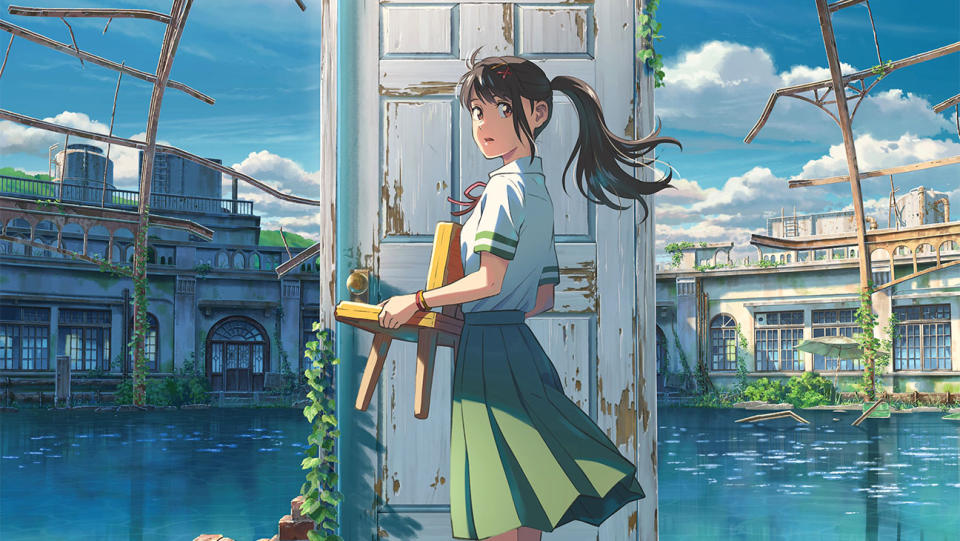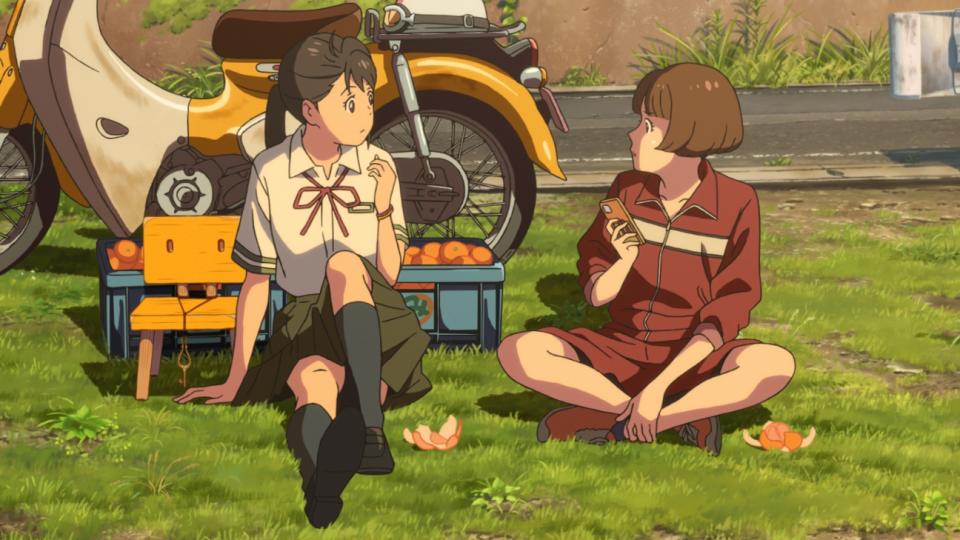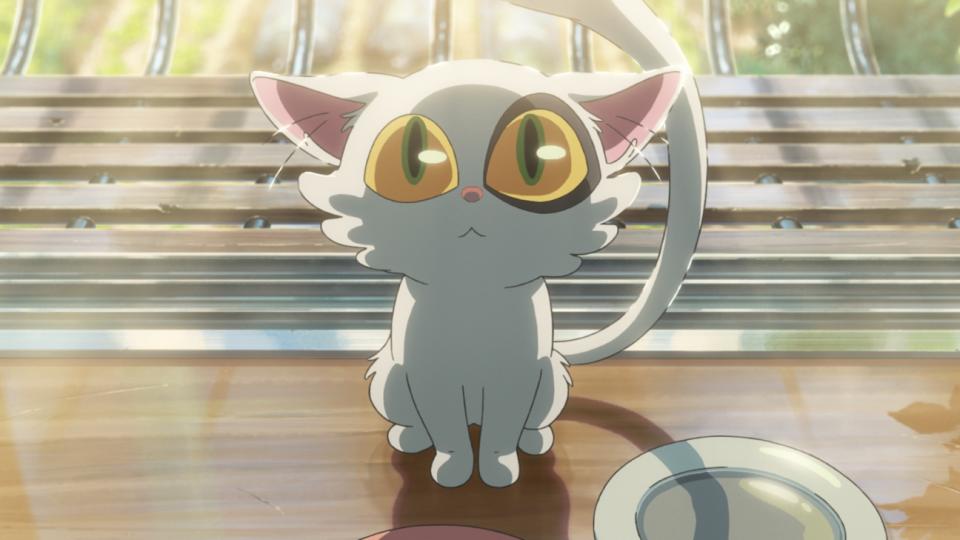Makoto Shinkai on How Anime Blockbuster ‘Suzume’ Reflects the Current State of Japan: “The Most Honest Expression I Could Put on Screen”
- Oops!Something went wrong.Please try again later.
- Oops!Something went wrong.Please try again later.

The 2023 Berlin International Film Festival is screening its first Japanese anime film in competition in over two decades. The previous occasion was the international premiere of Hayao Miyazaki’s Spirited Away in 2002, so it’s perhaps fitting that the latest selection is Suzume, the newest release from Makoto Shinkai, the director most often hailed as Miyaki’s heir as Japan’s next historic anime talent.
Like his past two anime blockbusters Your Name (which earned $357 million worldwide in 2017) and Weathering With You ($193 million, 2020), Suzume tells a YA story of fantasy, adventure and romance, involving characters coping with a sense of loss and cataclysmic disaster. The new film follows a high-school girl named Suzume who meets a mysterious young man named Sōta and becomes involved in his mission to track down and close a sequence of mysterious metaphysical doors that are opening in abandoned areas of Japan and threatening the entire country with disaster.
More from The Hollywood Reporter
Warner Bros. Discovery Renews HBO Content Deal With Japan's U-Next Streaming Service
Netflix Creatives, In Amsterdam, Talk About Why They're Working With the Streaming Giant
'Ted Lasso' Fans Can Cheer for AFC Richmond With These Tees and More Official Season 3 Merch
Suzume opened in Japan late last year and earned $103 million. After its international premiere in Berlin, the film will roll out in international markets throughout the spring, likely becoming one of the world’s biggest animated releases of 2023.
Ahead of the Berlinale, The Hollywood Reporter met with Shinkai in Tokyo to discuss how his recent filmmaking represents an evolving response to Japan’s 2011 Tōhoku earthquake and tsunami, the new movie’s charming references to Miyazaki and how the work is representative of the spirit of the times in his country.
What were the origins, or creative genesis, of the ideas and themes behind Suzume?
I had a few different ideas that developed over time, so it’s really hard to pinpoint any single concept or idea where the inspiration came from. Fundamentally, it was the 2011 earthquake that hit the east side of Japan that inspired me to make this film. And it was that incident that made me want to take these themes of disaster into my work and translate them into animation, beginning with Your Name and also with Weathering With You. But when thinking about Suzume, I wasn’t really looking at the earthquake as the core concept; what I really wanted to do was showcase Japan and make this film where you journey through all different locations throughout the country. So, I was first thinking about how to make this a road movie and an adventure film —one that examines Japan in its current state. And I kept coming back to this idea of these unlivable locales throughout the country, caused by either disaster or population decline (as Japan’s population has begun to plummet, thousands of homes, and even entire villages and suburban developments have fallen into abandonment in recent years). There are these various ruins throughout the country that I thought would make for a good backdrop. And thinking about where our characters would end up through this adventure, I kept coming back to the northeastern area of Japan where the Great East Japan Earthquake hit the hardest. It really made me think about how the 2011 earthquake has really been on my mind throughout my entire career in recent years. So, when thinking about where the characters would reach the end of their story, I thought it would be important to take this issue — the earthquake — almost head-on to understand it better.

These abandoned places have become such an unavoidable part of contemporary Japan. What attracted you to these places as a film setting?
Well, around the world, of course, there are ruins of various types, and I guess there are people, you could say, who are kind of obsessed with these places. In some way, ruins do have a certain weird beauty and romance, as well as something scary about them. When you go there and experience them firsthand, there is a sadness but also a warmth about them. So, I can sympathize with the people who find that attractive, but I wouldn’t say that I’m one of those ruin hunters or fans.
With Suzume, I was drawn to them simply because, in Japan, modern ruins are popping up in more and more parts of the country. It’s not just in the remote countryside or the suburbs anymore. Even in Tokyo, I come across akiya (abandoned houses) in all kinds of neighborhoods. So, when considering the Japanese audience, I felt that this would be a very strong motif that everyone could relate to, because of how commonplace these sights are becoming.
I feel that whatever stories are told through a country’s entertainment are at least somewhat reflective of that country’s current state, whether it be the economic situation, the political power standing, or just the general vibes that the country has at a given time. So, if you look at some of Miyazaki’s films, like Laputa: Castle in the Sky or Porco Rosso, for example, they are very bright and they feel full of hope, and I definitely think that’s reflective of the era in which he was making those films. On the other hand, if you look at Suzume, there’s this emptiness or this feeling of loss — the feeling that something is disappearing. In a similar way, I feel that’s reflective of the state of Japan as we see it in the current era.

In the film, Suzume encounters these metaphysical doors, which have the potential to release disaster — and she always finds them in the ruins and abandoned developments we’ve just been discussing. One of the secrets she learns for closing the doors is to imagine the past lives and feelings of the people who once lived there — to conjure their former vitality and sentiments. Can you share a little more about how this idea is your answer to the feeling of loss that is emblematic of Japan in these times?
That’s a very interesting question but one that I will find very difficult to answer. Frankly, it’s very hard for me to describe this in words. I feel that the movie itself is my answer in many ways. If you look at Japan as a country, it is in a state of decline and there are a lot of natural disasters that plague the country every year. If I did have a simple answer for how to counter this, and how to process the feelings associated with those problems, that would obviously be best. But since I don’t, I choose the medium of animated film as my way to convey these emotions. If there’s any positive emotion or energy that the audience feels through this movie, that is my truest answer to the question you just posed.
But if I did have to try to put it into a few words, perhaps what I would say is that, through these difficult times, what’s really important is what’s in people’s minds and hearts. If you look at Suzume’s journey throughout the movie, she encounters so many people who are very kind to her. After their brief encounter, they give her a hug, or give her some clothes and help her on her way. And it’s that strength from communication and kindness from others that drives Suzume forward and ultimately allows her to come face to face with herself. She’s communicating with herself in the Ever After (the metaphysical world that exists behind the mysterious doors). I think this is something that we do daily — we’re communicating not with ourselves in the present, but rather slightly in the past or slightly in the future. You tell yourself, “hey, you know, it’s going to be better in the future, I just have to get through this”; or you look back and reflect on how things were and how they have turned out — to understand who you are now So, thinking about this interface of how we communicate with ourselves across time is a very central theme in this film.
Tell us about how the decision to have the character Sōta get stuck embodied in Suzume’s broken, three-legged children’s chair. It’s such a whimsical notion to take the handsome male lead and make him into a piece of furniture — and a piece of furniture that then participates in thrilling action sequences.
First and foremost, with the expression of the character as a chair, a big motivation was to find ways to lighten the mood of the entire film. We have our protagonist traveling to these various ruins throughout the country, ultimately ending up in the northeastern part where the 2011 earthquake hit the hardest. And if we were only following our female protagonist all alone throughout this, I think that that would present a much heavier film in many ways. So, I wanted to offset that with an adorable character — one that even if it’s just walking around will put a smile on people’s faces — and have it be our protagonist’s partner throughout this journey. As for what the three-legged chair symbolizes, Suzume is a victim of this massive disaster and there’s profound loss in what she has experienced. And even though it’s not depicted in the film itself, I imagine that this chair that she has carried with her was probably swept up in the tsunami and lost one of its legs in the destruction, so it’s reflective of Suzume’s state of mind after everything she’s been through. Even though it’s lost one of its legs, it’s still persevered, and in many ways, it’s still able to fulfill the functions that it’s intended to have as a chair. Another metaphor behind the chair has to do with how this film, in many ways, has a very unique backdrop, because we were working on it during COVID and there were many lockdowns and restrictions across the entire country then. There were all these tight rules that governed our daily lives. I think a lot of the younger generation felt trapped during this period. So, it’s that younger generation’s sensation of feeling trapped that I’ve projected onto Sōta when he’s trapped as the chair and has to go through those awkward movements. Beijing trapped inside that very tight, hard surface — it’s a feeling that young people will understand from the pandemic.
You’re occasionally mentioned as Miyazaki’s heir as Japan’s next great anime talent. This film has some very overt and fun references to his work — a cheeky talking cat that follows Suzume around and some iconic pop songs by Yumi Arai — both beloved elements from Miyazaki’s Kiki’s Delivery Service. Can you share a little about the decision to include these hat-tips?
Well, Kiki’s Delivery Service is one of my many very favorite films from director Miyazaki, of course. But I intended the references not only to pay my respects but also to position Suzume as an extension of our reality, if you will. If the 2011 Earthquake exists in the world of the film, then if you look a little further down the path in that reality, Studio Ghibli should exist, too, along with Japanese classic pop on the radio. Kiki’s Delivery Service is a shared experience that almost everyone in Japan treasures, so by having it referenced as part of the world of the film, it helps plot these dots that form a line that creates the feeling that the film’s world is an extension of our own reality.
At one point, Suzume says that she believes that whether people live or die is just a matter of luck. And despite its supernatural elements, the film operates on that principle. Later, though, she’s able to tell her younger self that life will be okay — that despite her profound loss, she will grow up and things will get better. I found the film to be an interesting mix of fatalism and big-heartedness — wise in a mature way. You said your last three films were all sort of inspired by a desire to reckon with the Great East Japan Earthquake. This one is by far the most overt in that respect. How do you think your response to that tragedy has evolved or grown through these three films?
I feel what I’ve done over my past three films is almost have this dialogue with my audience over time. After the 2011 earthquake, I made Your Name. And there was feedback from the audience. Of course, I paid a lot of attention to what people were saying about the film. A lot of people said it was fun. Some, however, thought that it was a complete fantasy, or a hoax, because you can’t revive people from the dead. They are lost and gone. So, there was some criticism of the core concept of that film, which then led me to work on Weathering With You, where the concept was about sacrificing one person versus the masses, and if that is a scale that can ever be balanced. And again, there was a group of people who had criticisms — that, hey, how can you not sacrifice one person when there’s millions of people whose lives are going to be affected by this one deed? So again, taking that feedback into consideration, I arrived at the concept of Suzume. So, I don’t know if I would call it an evolution, per se, but through my films, I’ve been having this evolving, constant dialogue with my audience. For me, personally, this is something that’s very fulfilling and I think it’s something that is unique to the anime medium, being able to have this dialogue on that scale. There is so much trust between anime artists and their audience, which has been steadily built up over decades. For me, Suzume was the best message I could put forward at this current stage in my career and in my life, and it was the most honest expression I could put on screen.


